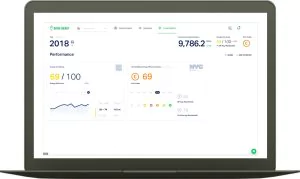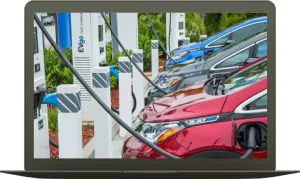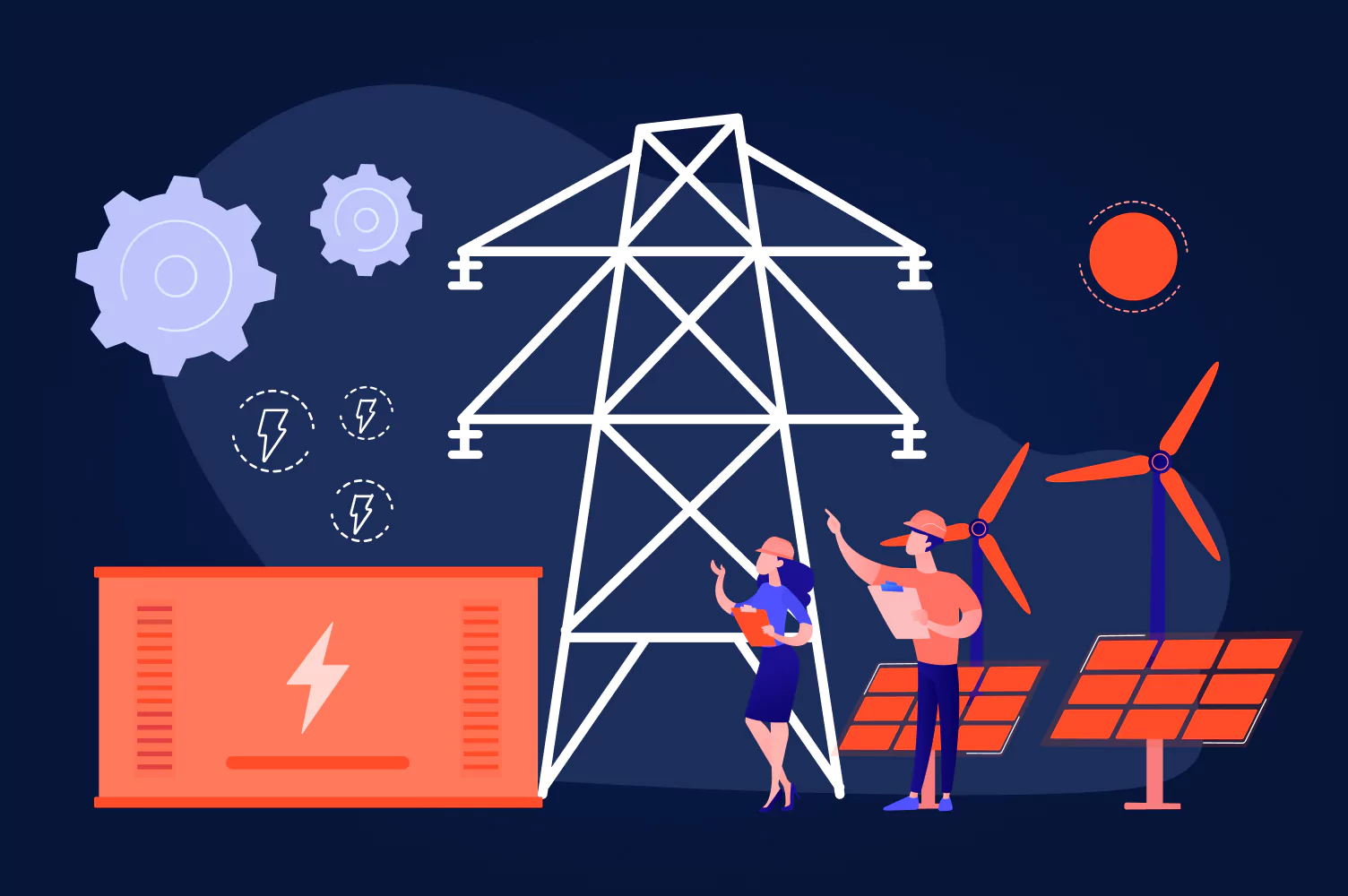Do you remember these days when some large company announces its sustainability program, and your reaction was like: “Wow, sounds weird, but cool. Are they serious?” Today, you can hardly find a business that doesn’t want to be sustainable. Sustainability, as well as environmental, social, and governance (ESG) standards significantly shape decisions companies make on a strategic level. For that reason, many businesses are laser-focused on energy management solutions as one of the critical components of their business strategy for the long-term future.
In 2020, almost 60% of companies reported having pressure from stakeholders about their carbon footprint and energy management, while 68% of their consumers admitted feeling concerned about impacts they make on the environment and energy use, in particular. There is no need to hazard a guess: companies do look for technology-augmented energy management solutions, which is why the latter are on a meteoric rise today.
Your energy management solution can also make a significant impact on the uphill battle against climate change and help businesses reach carbon neutrality. In this article, the JatApp team will tell you how to make it possible.
Converging trends that drive the market
Once enterprises, particularly industrial ones, are pivoting to a more sustainable future, with a careful attention to energy efficiency, the market of energy solutions is mainly driven by three major trends: electrification, industry 4.0, and energy optimization. After understanding why these trends emerged, you’ll learn what problems your energy management solution is expected to tackle. No need for a storm in a teapot here, we’ll talk about everything in detail.
Electrification
As long as businesses strive for decarbonization, making their operations powered with electricity instead of fossil fuels has become a centerpiece of their sustainability efforts. It’s fair to say that companies don’t wait for the moment when the lightning strikes their grids and they get enough electricity to power up their infrastructure.
Although, electricity production also requires fossil fuels, and many companies realize that just electrifying everything would be paying lip service to sustainability. Under these circumstances, energy management software that can help businesses truly pursue carbon neutrality are gaining serious traction today.
On top of that, sustainable business isn’t just a voluntary decision of environmentally conscious entrepreneurs. It’s a must. ESG goals throw enough oil on the fire to make businesses act responsibly. The first letter of the acronym stands for “environmental” which means that businesses that want to get investment and customer loyalty have to be solemn about their carbon footprint, energy management, use of eco-friendly materials, nature protection, and so on.
Sustainable development and decarbonization are processes that businesses can’t leave halfway through. Either companies fully commit to ESG goals or they’ll be left in dust forever. That is why adoption of energy management solutions is a natural outcome of massive electrification amongst enterprises and big industrial players.
Industry 4.0
A massive digitalization of industry is another tailwind that speeds up adoption of energy management solutions by businesses. And again, the reason is plain as day. Industry 4.0 stands for a digital transformation of companies by all means: artificial intelligence (AI), Big Data analytics, Internet-of-Things (IoT) devices, and such are making businesses capable of making more informed decisions and planning their performance with better accuracy.
In the line of energy management, many aspects are turning tectonic. The use of IoT devices enables companies to collect and process data about their carbon footprint and energy consumption while, AI algorithms and Big Data analytics can provide valuable insights about how businesses can optimize their energy use, reduce emissions, and save money.
Availability of technologies brought by Industry 4.0 simply means that there is a technical possibility to build industrial energy management software. It is your watershed moment, as you can have all necessary ingredients at your fingertips and develop an energy management solution the world hasn’t seen before.
Energy optimization
Embracing carbon neutrality, however, does have its own challenges. A heavy reliance on electricity can backfire with various problems, if left unmanaged. Companies are concerned about the resilience of their grids and power storages. In case of power outage caused by anything, performance downtime means that a business suffers a financial loss.
Sending curses to environmentally conscious investors, customers, governments, and almighty Greta Thunberg won’t return a company money it lost because of expecting that the electricity supply channel is invincible. Again, going sustainable means full commitment, and thinking in advance about hurdles and threats to power supply is a duty of each business.
With this being said, we would like to highlight that when companies think about energy efficiency, they have to consider two main issues: their grid resilience and potential cost savings. Nonetheless, it’s impossible to make business electrified in a cost-prohibitive manner, since companies need to spend money first. And sending a lot of money in the beginning will cut the costs in the long run.
These two factors bring us to a subject of renewable energy. The matter is that renewable energy resources are much cheaper than fossil fuels electricity. Deloitte reports that 48% of industrial companies intend to adopt energy efficiency solutions because of cost savings opportunities. Quite logical, taking into account that 56% of enterprises expect an increase of electricity expenses by 5% in the near future.
You can see that a need for energy cost and resilience optimization are a call to build robust renewable energy sources and power storages, which enterprises can cater to. Overall, these converging trends are the advent of a surge in energy management solutions that we’re going to discuss right now.
Top solutions and how they work
Even though you might already have an image of what energy management solutions are today, we need to clearly determine what an energy management system is. An energy management system is software used for measuring, analyzing, and controlling energy use, sources, facilities, grids, and other equipment related to energy supply and storage.
This definition can make you think that energy management solutions do differ depending on purpose, technology, and business scale. And you’re absolutely right! Let’s take a look at the energy management technologies that emerge from the converging trends we’ve discussed above.
How a typical energy management system architecture looks like
Flexible energy load
Energy management software has a growing influence over the decision making process in enterprises, but we need to remember that even the largest enterprises are run by people. And people are lazy. If a human has the simplest way to do something, they’ll go this way.
Energy efficiency is no exception, which is why flexible load solutions are the simplest approach to saving energy and costs. Flexible load means that an energy provider supplies each organization individually, according to their current energy demand. As soon as a particular company needs more energy, they send a request to the energy provider manually or automatically.
How flexible load energy supply works
Beyond a doubt, automating these requests is a clear sign of Industry 4.0 in the energy sector, so we recommend you develop your flexible load solution with a full package of features: AI-based demand response automation, price decrease notifications, energy consumption analytics, and grid predictive maintenance.
However, on-demand energy supply isn’t the only way you can sell your flexible load solution. David Energy, a startup from New York, supplies commercial customers with electricity at a fixed price that is lower than the market average. The company connects to different energy providers in the region to keep its own expenses low and earn on the difference between the prices.
The startup offers its own Software-as-a-Service (SaaS) product that is included in the service price. By using this software, the startup’s customers can view their energy consumption and availability of renewable energy sources to switch on.
DavidEnergy software’s dashboard
We can also single out a separate trend on microgrids, which work almost in the same way as flexible load solutions. With a microgrid, a company has access to different sources of energy, which means less risks of power outage and access to renewable sources.
Microgrids are very similar to flexible load solutions, but the main advantage of a microgrid is its better independence from a power provider. Almost any microgrid involves its own storages, thereby preserving some power for cases when an electricity supplier isn’t available because of power outage or any other unexpected circumstances.
Offering microgrid energy management solutions still requires you to build a robust software that can help users control their microgrids and monitor energy consumption. Anyway, you should expect closer cooperation with your clients — installation and maintenance of microgrids will be your duty.
Onsite renewable production and storage
Doing more with less is good for any business, but many companies may not cover their energy demand with flexible loads and they can afford getting their own source of energy. That’s why onsite renewable energy generation and its storage is another green energy management solution that gains a foothold in the market.
First, you need to provide your clients with renewable energy sources like solar panels, wind turbines, biofuels, to name a few.
Second, it’s essential to provide storage. Today, batteries are a total dominator of the energy storage industry. According to the abovementioned Deloitte report, 41% of companies confirm that they would like to save extra renewable energy within their battery storage facilities, while battery installation and maintenance costs dropped down dramatically by 90%.
And the third thing you must keep in mind is software. Again, your solution has to include smart analytics, energy demand prediction, battery capacity diagnostics, and management of all your connected devices, be it solar panel, wind turbine, or anything else.
Electric vehicles and charging stations
Electric vehicles (EVs) have become an essential part of sustainable business as companies use EVs for logistic operations across the whole supply chain. While EVs themselves aren’t a big phenomenon today, infrastructure around electric vehicles is a source of inspiration for many startups.
Except for the three converging trends, lack of infrastructure causes a need for major improvements and expansion. First of all, the network of charging stations should be sufficient to enable EVs to move across large distances without facing problems with powering up an electric car.
JatApp can proudly toot its own horn here, since our team worked on electric vehicles charging stations monitoring platform for our client from Switzerland. The customer has a network of charging stations for EVs across the whole Europe, but the company faced a common problem: connectivity of charging stations.
By being connected to the Internet, each charging point can send important information about its performance status, availability, and downtime. In such a way, monitoring each station remotely enables the company, its corporate customers, and EV drivers to see whether the nearest charging station is available and working properly. EV owners can be sure that they will charge their car easily, while the company and corporate clients will be able to take an immediate action if any of the stations unexpectedly halts.
List of charging stations in the monitoring platform web application
To develop such a solution, JatApp team involved a project manager, user interface/user experience (UI/UX) designer, two frontend developers, one backend developer, and quality assurance engineer. Speaking about a tech stack for this project, we used PHP (Laravel) for backend development, VueJS for the frontend, and MySQL for building the database.
Still, we would like to draw your attention to an important challenge you will have to deal with. Since charging stations should be connected to the Internet, it means that each charging point is literally an IoT device.
Connecting each station to the network was the biggest roadblock for our team during this energy management project. JatApp resolved the issue by using relatable IoT protocols for connecting charging points to the network. We used OCPP 1.6 and OCPP 2.0 protocols that are specifically designed for connecting electric vehicles, charging stations, and wide-area networks.
Well, we’ve described everything on the front of EVs and charging stations, but there are opportunities beyond this kind of energy management. You can develop a similar solution, but add an extra feature that informs EV owners about the lowest charging prices and availability of green energy sources. You may even offer a charging-station-as-a-service business model.
If you think it’s not enough for your energy management solution, you can add an extra layer to the equation and include a feature of discharging EVs by giving the power back to the network and getting money in return. In such a way, your customers can earn some money when they don’t plan to drive their EVs, while you get extra power in the network at a low price.
Now you see that EVs and relatable infrastructure make enough waves in the industry of energy efficiency. We highly recommend you to think about your own solution in this domain. The EV infrastructure market is exploding now, so your digital product can take this disruption to the next level.
Building energy management solutions
Buildings account for 15% of direct carbon dioxide emissions in the world. Decarbonization of both residential and commercial real estate is an important concern because keeping comfortable living conditions inside each building converts in carbon emissions.
It doesn’t necessarily mean that the planet is doomed because of our homes — it’s just a sign that the segment of building energy management solutions is fertile ground for many software products.
Building energy management system (BEMS) or building energy optimization software (BeOpt) are digital solutions that collect and process data related to energy consumption, performance of facilities, peak performance hours, and other information relatable to power use inside the building. Such software solutions often connect to smart home kits, building automation systems, and heating, ventilation, and air conditioning (HVAC) facilities.
By gathering the data about power use, BEMS can automatically control the power consumption by switching off a particular device or adjusting heating temperature to acceptable yet comfortable level. In addition, BeOpt software provides analytics of energy use and carbon footprint reduction in order to inform homeowners and facility managers about the best energy efficiency decisions.
The JatApp team worked on the development of UI/UX design for a building energy management software that is powered with artificial intelligence. A user needs to submit the basic data about the building, and the solution will automate all energy processes within next week. The product is fully automated due to smart AI algorithms, and users have access to a wide range of features such as analytics, reporting, permission management, buildings widgets, and the like.
We need to note that an advanced yet intuitive UI/UX design is a key factor in making a BEMS solution effective. Thanks to a deep business analysis done by our project manager, JatApp’s designers had an idea of what they were expected to create. As a result, the BEMS solution got an attractive and easily navigable user interface.
The solution’s dashboard
But the design is nothing without software’s back and front end. That’s why the development team involved project manager, UI/UX designer, back-end developer, front-end developer, and quality assurance engineer. As for the tech stack used, please look at the table below:
The estimated budget for the first version of a similar solution will be around $98, 000, and you can expect that the project will last for almost a year.
People are an essential component of energy management solutions
We bet that now you have little doubts about why enterprises push themselves hard to manage their energy consumption. That is why today is the perfect time for your product to hit the market. We have talked a lot about technologies, but you should remember that any energy management solution has a team of professionals behind it.
JatApp can help you to assemble a team of tech talents who will take care of your project. Our company has been working on software development since 2015 and we have access to the largest talent pool in Eastern Europe. We can provide you with a team of software engineers who will deliver a quality solution. If you don’t have any clear idea in mind yet, we will conduct a profound business analysis and offer you development of an energy management solution that will be valued by your target audience.
Start developing your energy management solution by contacting us. We will get back to you as soon as possible.




















